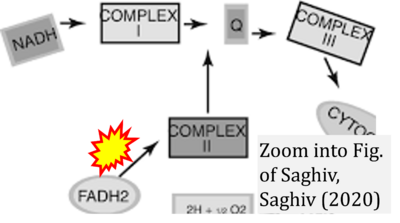Difference between revisions of "Saghiv 2020 Springer, Cham"
(Created page with "{{Publication |title=Saghiv MS, Sagiv MS (2020) Metabolism. Springer, Cham In: Basic Exercise Physiology. https://doi.org/10.1007/978-3-030-48806-2_2. |info=[https://link.spri...") |
|||
| Line 10: | Line 10: | ||
|editor=Gnaiger E | |editor=Gnaiger E | ||
}} | }} | ||
[[File:Saghiv 2020 Springer, Cham CORRECTION.png|right|400px]] | [[File:Saghiv 2020 Springer, Cham CORRECTION.png|right|400px]] | ||
{{Template:Correction FADH2 and S-pathway}} | {{Template:Correction FADH2 and S-pathway}} | ||
Revision as of 14:28, 19 December 2023
| Saghiv MS, Sagiv MS (2020) Metabolism. Springer, Cham In: Basic Exercise Physiology. https://doi.org/10.1007/978-3-030-48806-2_2. |
» Springer
Saghiv MS, Sagiv MS (2020) Springer, Cham
Abstract: Metabolism is a chain of chemical reactions that are connected in a sequence of pathways. Thus, the sum of an organism’s chemical reactions is called metabolism. It is a harmonizing act among molecular building reactions and degradation of molecules in the body. Therefore, the chemical reactions of living are planned through metabolic pathways. A specific molecule is transformed into a specific molecule, with a specific enzyme that catalyzes each step of the metabolic pathway. The capacity to perform work (biomass energy) is the study of how organisms manage their energy resources. Energy exists in numerous forms, and cells transform chemical energy into mechanical one; body motion, pumping of substances across membranes, and driving chemical reaction in which the standard change in free energy is positive, and energy is absorbed. In cells, critical molecules are either built by connecting small units such as amino acids or nucleotides or degraded into smaller components. Respectively, the reactions responsible for this are referred to as anabolic and catabolic. These reactions consume or yield energy usually in the form of a molecule called adenosine triphosphate. These two progressions compose cell metabolism. Cellular respiration is a catabolic process, the main pathway of catabolism, where it releases energy by degrading complex molecules to smaller composites, such as energy released from glucose breakdown, and is stored in the adenosine triphosphate molecule to release later, the released energy is used in the cell for anabolic pathways. Photosynthesis is an anabolic process done by plants that use energy from sunlight to build complex molecules from smaller composites, sugar, as an example, is formed by the reaction of carbon dioxide gas with water. Thus, all the anabolic processes need additional energy to build different molecules. Some of the glucose produced by the planet is used by the plant itself or is used as a nutrient source by other organisms.
Countless metabolic reactions happen at the same time. Thousands of metabolic reactions occurred simultaneously, all synchronized with one another and controlled cautiously to insure body’s functioning correctly. Finally, this chapter also deals with how modifications in metabolism that go together with metabolic disorders, or that occur following introduction to environmental stressors, can be alleviated by exercise training.
• Bioblast editor: Gnaiger E
Correction: FADH2 and Complex II
- FADH2 is shown as the substrate feeding electrons into Complex II (CII). This is wrong and requires correction - for details see Gnaiger (2024).
- Gnaiger E (2024) Complex II ambiguities ― FADH2 in the electron transfer system. J Biol Chem 300:105470. https://doi.org/10.1016/j.jbc.2023.105470 - »Bioblast link«


